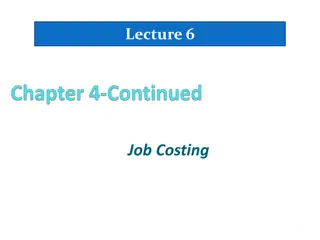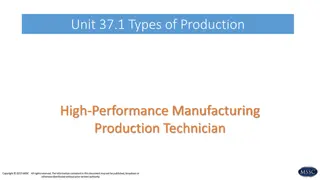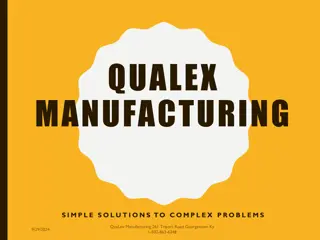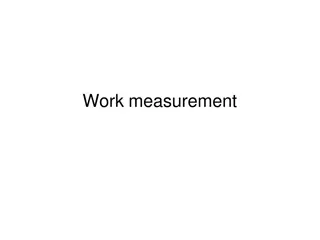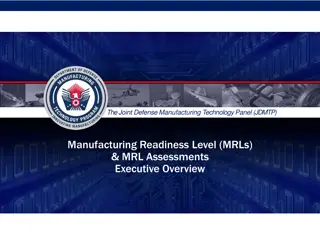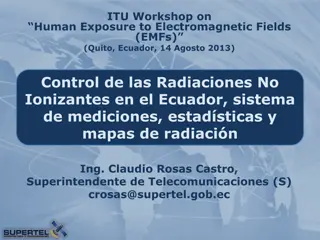Understanding Work Measurement Techniques in Manufacturing
Work measurement involves establishing the time required for an average worker to complete a specific manufacturing task at a defined level of performance. Techniques such as time study, activity sampling, and predetermined motion time systems help identify and eliminate ineffective time, improving operational efficiency and productivity in manufacturing processes.
Download Presentation

Please find below an Image/Link to download the presentation.
The content on the website is provided AS IS for your information and personal use only. It may not be sold, licensed, or shared on other websites without obtaining consent from the author. Download presentation by click this link. If you encounter any issues during the download, it is possible that the publisher has removed the file from their server.
E N D
Presentation Transcript
Work measurement is the application of techniques which is designed to establish the time for an average worker to carry out a specified manufacturing task at a defined level of performance. It is concerned with the duration of time it takes to complete a work task assigned to a specific job. It means the time taken to complete one unit of work or operation it also that the work should completely complete in a complete basis under certain circumstances which take into account of accountants time
Work Measurement is a technique for establishing a Standard Time, which is the required time to perform a given task, based on time measurements of the work content of the prescribed method, with due consideration for fatigue and for personal and unavoidable delays. Method study is the principal technique for reducing the work involved, primarily by eliminating unnecessary movement on the part of material or operatives and by substituting good methods for poor ones. Work measurement is concerned with investigating, reducing and subsequently eliminating ineffective time, that is time during which no effective work is being performed, whatever the cause. Work measurement, as the name suggests, provides management with a means of measuring the time taken in the performance of an operation or series of operations in such a way that ineffective time is shown up and can be separated from effective time. In this way its existence, nature and extent become known where previously they were concealed within the total.
1. Time study 2. Activity sampling 3. Predetermined motion time systems 4. Synthesis from standard data 5. Estimating 6. Analytical estimating 7. Comparative estimating
Activity sampling is a technique in which a large number of instantaneous observations are made over a period of time of a group of machines, processesor workers. Each observation records what is happening at that instant and the percentage of observations recorded for a particular activity or delay is a measure of the percentage of time during which the activity or delay occurs.
A predetermined motion time system is a work measurement technique whereby times established for basic human motions (classified according to the nature of the motion and the conditions under which it is made) are used to build up the time for a job at a defined level of performance. The systems are based on the assumption that all manual tasks can be analysedinto basic motions of the body or body members. They were compiled as a result of a very large number of studies of each movement, generally by a frame-by-frame analysis of films of a wide range of subjects, men and women, performing a wide variety of tasks.
The first generation of PMT systems, MTM1, were very finely detailed, involving much analysis and producing extremely accurate results. This attention to detail was both a strength and a weakness, and for many potential applications the quantity of detailed analysis was not necessary, and prohibitively time -consuming. In these cases "second generation" techniques, such as Simplified PMTS, Master Standard Data, Primary Standard Data and MTM2, could be used with advantage, and no great loss of accuracy. For even speedier application, where some detail could be sacrificed then a "third generation" technique such as Basic Work Data or MTM3 could be used.
Synthesis is a work measurement technique for building up the time for a job at a defined level of performance by totaling element times obtained previously from time studies on otherjobs containingthe elements concerned, or from synthetic data. Synthetic data is the name given to tables and formulae derived from the analysis of accumulated work measurement data, arranged in a form suitable for building up standard times, machine process times, etc. bysynthesis. Synthetic times are increasingly being used as a substitute for individual time studies in the case of jobs made up of elements which have recurred a sufficient number of times in jobs previously studied to make it possible to compile accurate representative times for them.
The technique of estimating is the least refined of all those available to the practitioner. It consists of an estimate of total job duration (or in common practice, the job price or cost). work measurement This estimate is made by a craftsman or person familiar with the craft. It normally embraces the total components of the job, including work content, preparation and disposal time, any contingencies etc., allestimated inonegross amount.
This technique introduces work measurement concepts into estimating. In analytical estimating the estimator is trained in elemental breakdown, and performance. in the concept of standard The estimate is prepared by first breaking the work content of the job into elements, and then utilizing the experience of the estimator (normally a craftsman) the time for each element of work is estimated atstandardperformance. These estimated basic minutes are totaled to give a total job time, in basic minutes. An allowance for relaxation and any necessary contingency is then made, as in conventional time study, to give the standardtime.
This technique has been developed to permit speedy and reliable assessment of the duration of variable and infrequent jobs, by estimating them within chosen time bands. Limits are set within which the job under consideration will fall, rather than in terms of precise capital standard or capital allowed minute values. It is applied by comparing the job to be estimated with jobs of similar work content, and using these similar jobs as "bench marks" to locate the new job in its relevant time band known as Work Group.




